The symbolism of flowers and fruit in Chinese art: 花朵 Huā duǒ

The symbolism of flowers and fruit in Chinese art is extremely diverse. This collection lists many individual flowers each with its own specific meaning. From very early times courtyard homes had a small garden at its heart. The character for flower 花 huā has an interesting origin. As a plant ‘magically’ transform from producing green leaves into producing flowers the character uses a head over heels representation to show this metamorphosis under the radical for a ‘plant’.
The twelfth day of the second lunar month is a minor festival to celebrate spring and the emergence of leaves and flowers; it is dedicated to the goddess of flowers 百花深 Bǎi huā shēn. Early spring blossom was particularly valued and used to decorate houses for the Spring Festival. For a long while it was the custom of women to wear a garland of flowers in their hair although white and blue flowers are unlucky and avoided. Flowers have long been associated with girls and young women, and a picture of a flower may represent one; a prostitute was often referred to as a ‘flower’.
Particular flowers are often depicted with a specific bird because they have the same symbolic meaning, so a crane and a pine tree both represent longevity. The four friends of the flowers are the swallow, oriole, bee and butterfly. While the three friends of winter are the pine, bamboo and plum blossom.
A basket of flowers is the emblem of Lan Caihe 蓝采和 who is one of the Eight Daoist Immortals. Each month is associated with a flower but the list varies from place to place. Here is a list of the traditional Chinese lunar months starting at Chinese New Year (not January):
1st: plum; 2nd: apricot; 3rd: tree peony; 4th: cherry blossom; 5th: magnolia; 6th: pomegranate; 7th:lotus; 8th:pear or quince; 9th:cassia or mallow; 10th:chrysanthemum; 11th:gardenia; 12th: poppy.
There is also a seasonal association too, the four virtuous plants 四君子 sì jūn zǐ are spring: orchid or magnolia, summer: peony or lotus, autumn: chrysanthemum and winter: plum or bamboo. These make up the four ‘flower tiles’ of the game of Mahjong.
Fruit
After the flowers comes the fruit. For a good number of the plants in Chinese symbolism it is the fruit rather than the flowers that are portrayed in artwork. So in this section we also include apples, aubergines, oranges, peaches, pomegranates and walnuts.
Here is an extensive list of flowers and fruit that are noted for their symbolism in Chinese art :
Apple 苹果 píng guǒ

Older varieties of apple prefer a cooler, moister climate than is generally found in China, so apples used to be imported from Korea and Japan making them an exotic luxury. Wild Chinese apple trees in Northern China are Malus spectabilis 海棠 hǎi táng which does not produce sweet fruit but are admired for their blossom in spring. The similar sounding 堂 táng means ‘hall’, so a picture of apple blossom can represent the home in a painting. 玉堂 Yù táng ‘Jade Hall’ is another name for the illustrious Hanlin Academy and therefore represents a wish for scholarly achievement. The combination of apple and magnolia together gives the phrase 玉堂富贵 yù táng fù guì meaning ‘be wealthy and honored’.
Wild apple blossom may represent female beauty, possibly from the celebrated Yang Guifei being termed the 海棠女 Hǎi táng nǚ ‘Paradise-apple maiden’ . ‘Apple’ in Chinese sounds the same as 平 píng ‘peace, calm’ so an apple is a hidden wish for peace. Together with a persimmon 柿 shì an apple wishes success in business affairs (事 shì).
Apricot 杏 xìng
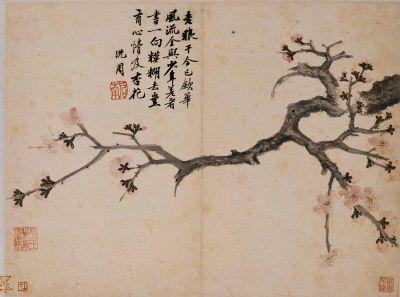
Apricots represent the second month of the traditional calendar as that is when they are in flower. Apricots and the closely related almond represent female elegance, perhaps because the large seed is ovoid shaped like the eyes of an Oriental beauty. A red apricot represents a woman having an affair. Sometimes an apricot is painted together with Imperial women to express the wish for fortitude in sorrows. All parts of the apricot tree have some sort of use in traditional medicine even though 'bitter almonds' contain cyanide!
A field of apricots can represent wish for success in examinations as celebrations used to take place in a grove of apricots.
Aubergine 茄子 qié zi
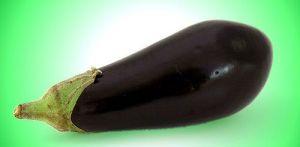
The eggplant or aubergine is used to symbolize an official because of the shape of the attachment to the stem looks like the hat of an official. More crudely its overall shape may bring to mind the penis.
Because qié zi sounds a bit like ‘cheese’ it is used in China to encourage people to smile while taking photographs.
Azalea 杜鹃花 dù juān huā
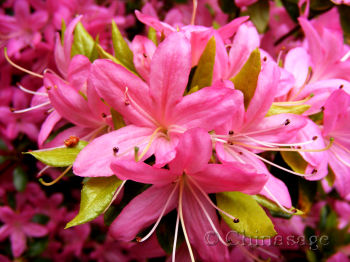
Some wild azaleas have a red blotch on the flower which has led to them being called ‘cuckoo flowers’ in Sichuan because the local cuckoo has a red throat. In Europe, the cuckoo flower ➚ is a completely different species (Cardamine pratensis) that flowers at the time when cuckoos arrive from Africa. Azalea stamens can be collected and used as a mild narcotic. Whole mountains are covered with azaleas in China making them a magnificent sight when in flower. The Dabie mountains in Hubei are particularly famous for its flowering azaleas. It often symbolizes female beauty in painting while in association with butterflies azaleas suggest artistic ability.
Bamboo 竹 zhú
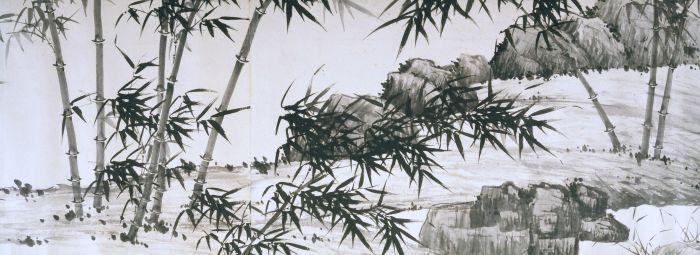
Image for Google Art Project ➚ available under a Creative Commons license ➚
Bamboo is such an important plant in China that we have written an extended section all about bamboo. Bamboo is used for every conceivable purpose from scaffolding to food and firecrackers to paper. Bamboo in art symbolizes longevity and steadfastness as it is both long lived and evergreen. As an evergreen it is, together with pines and plums, regarded as one of the three friends of winter. As a lush plant it represents summer in the 四君子 Sì jūn zǐ ‘Four Gentlemen’. The bamboo stem (culm) is hollow and its leaves droop so it represents modesty: (虚 xū means both modest and hollow). Along the stem are the joints 节 jié which also means ‘festival’ and ‘moral integrity’. Its straight, un-branched habit exemplifies virtue and honesty. It is supple, graceful and very useful – making it a suitable paragon of virtue for both Confucians and Daoists.
The character for laughter uses the radical for bamboo suggested by the rocking and rustling of bamboo plants in the wind. Bamboo explodes, noisily, when burnt and so was originally used for the casing of fire crackers 爆竹 bào zhú ‘exploding bamboo’. Bamboo is also one of the ‘suits’ in the game of Mahjong. The character to express good wishes is 祝 zhù which sounds similar and so bamboo as a decoration expresses a wish for peace and happiness. Together with plums it may represent husband and wife in a painting. Because it is such an quintessential motif in China, some painters have dedicated their lives to painting nothing except bamboo.
Basket 篮子 lán zi
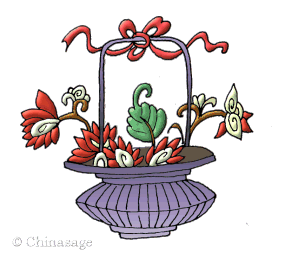
A basket of fruit symbolizes the Chinese Daoist immortal Lan Caihe. Lan Caihe is portrayed as a woman or an hermaphrodite and plays heavenly music. The basket symbolizes riches and is popular as a wish for good luck at the Spring Festival.
Bean 豆 dòu

Beans are a major source of protein for the many vegetarians in China. The beans are processed into bean curd 豆腐花 dòu fǔ huā or 豆花 dòu huā – it is from Japan that we get the name ‘tofu’. ‘Dou’ sounds similar to 到 dào ‘to attain; to arrive’ so it sometimes has that symbolic meaning. The dried beans mixed with water make a milk-like liquid : soy milk 豆浆, dòu jiāng and this is then left to coagulate into soft bean curd blocks. “Eating bean curd” is sometimes used as a euphemism for making love.
Bottle gourd 葫芦 húlú

The large, tough fruit of the gourd plant ‘Lagenaria siceraria’, when dried and hollowed out makes a water-tight container. The cheap and useful gourd was used as a water container from ancient times in China (especially southern China where the plant grows best). It often forms a ‘double’ gourd - when the shape has a distinct waist between upper and lower bulges. It has also been used as a buoyancy aid for children and can be forced to grow into a shape to form a suitable container in which to keep a cricket as a pet. It formed an emblematic feature of the wandering Daoist adept who would use it to store his magic potions. Hù 护 sounds the same and means ‘protect’ while 祜 hù means ‘blessing’. In legend, a Daoist master could be trapped within a gourd and later emerge just like the story of the genie and the magic lamp. By association a picture of a magic gourd is used to fend off evil.
The gourds are often painted, usually with flower and leaf motifs to match the shape of the gourd. A gourd is associated with one of the Eight Immortals Li Tie Guai 李铁拐 with wisps of white smoke emanating from the magic potion within the gourd. In a picture large 瓜 guā and small gourds 瓞dié together with 蔓màn ‘creeper’ (sounding like 万 wàn ‘numerous’) represent a wish for many descendents 瓜瓞绵绵 as the gourds contain many seeds.
Cabbage 菜 cài

Cabbage as (白菜 bái cài ‘Chinese cabbage’) or 青菜 qīng cài ‘green cabbage’ has a lucky connotation because 财 cái means ‘wealth, money’. The key symbolism is that the core is white and pure and so is a person's nature. One of the most famous pieces of jade sculpture is a cabbage with a locust and katydid now at the National Palace Museum ➚ in Taiwan.
The best known variety of Chinese cabbage is called by its Cantonese name of Bok Choy ➚ with white stems and dark green leaves but there is also Napa cabbage which is ‘White Cabbage’ 白菜 bái cài just to confuse matters.
Cherry 樱桃 yīng táo
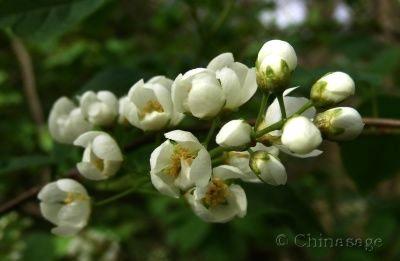
The cherry tree grows in northern and central China, the fruits of the wild species are fairly bitter in taste and so were used mainly for medicines. Its name in Chinese means ‘baby peach’. A color of a woman’s lips are often likened to a cherry and in general is associated with youthful beauty. It is considered one of the flowers in the garden of the Queen Mother of the West and from that an association with longevity. The phrase ‘eating cherries’ has to be used with care as it is another euphemism for making love.
Chrysanthemum 菊 jú

The chrysanthemum is a much loved flower in China and is often portrayed in pictures. It is a symbol of joy and a wish for peaceful retirement. It sounds similar to 居 jū ‘to reside, to endure’ and久 jiǔ ‘long time’. The pine and chrysanthemum together emphasize the wish for a long life as in 松菊犹存 sōng jú yóu cún ‘The pine tree and chrysanthemum outlast all things’. A picture of a chrysanthemum with nine quails symbolizes a wish for nine generations to live in peace in the home 九世同居 jiǔ shì tóng jū. The plant represents the season of autumn and so contrasts with the plum which is the flower of late winter. It can withstand frost and so exemplifies stoicism in the face of disappointments in life.
There are many varieties of chrysanthemum in a great range of colors and flower shapes. Its importance can be judged by the fact that the ninth month in the traditional calendar is named the ‘chrysanthemum month’. The petals can be used to make a soothing, herbal tea and the petals are used to flavor wine which is often drunk at the Zhong Yang or Double Ninth Festival. The love of chrysanthemums spread to Japan and there the Emperor of Japan's throne is known as the Chrysanthemum Throne ➚.
Cinnamon 桂 guì
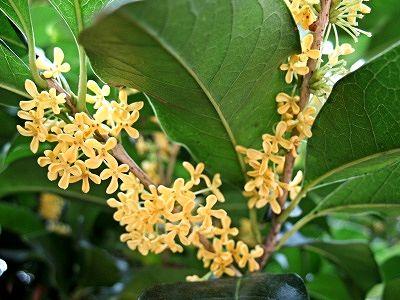
The Chinese cinnamon or Cassia spice tree (Cinnamomum cassia) is native to southern China. Its aromatic bark has been used in cooking for thousands of years. Guì huā 桂花 can also refer to the Osmanthus (Osmanthus fragrans) or ‘sweet olive’ or ‘tea olive’.
The city of Guilin 桂林 in Guangxi is named after the many osmanthus trees that have been planted there. Osmanthus flowers give a fine fragrance which is given the same character as cassia. The osmanthus blossoms in the 8th lunar month so the month was called 桂月 guì yuè. When depicted with the plum which flowers in spring it denotes a wish for never ending fragrance – a long honorable life. With pomegranate and gourds it gives the wish for many successful sons. It sounds the same as 贵 guì ‘expensive, noble, valuable’ and so the fine scent became associated with passing the Imperial examinations and also because it blooms at the time when the examinations were held. The inscription 桂子兰孙 guì zǐ lán sūn expresses a wish for noble sons and grandsons.
It is a fast growing tree and there is a legend that there was a giant cinnamon tree which grew so fast that its owner could never keep it under control. There is also a legend that the moon has a magical cassia tree which generates a drug giving immortality.
Creeper 蔓 màn
A creeping plant often with tendrils (especially vines) is sometimes used in paintings to symbolize immortality. This is because 蔓 màn sounds a bit like 万 wàn ‘10,000, myriad, numerous, forever’. If the picture shows roots (柢 dǐ) of a tree this symbolizes numerous generations (代 dài). Grapes and grapevines are a common motif on Ming dynasty porcelain. Vines are often shown in combination with rats, gourds and grapes.
Cypress 柏 bǎi
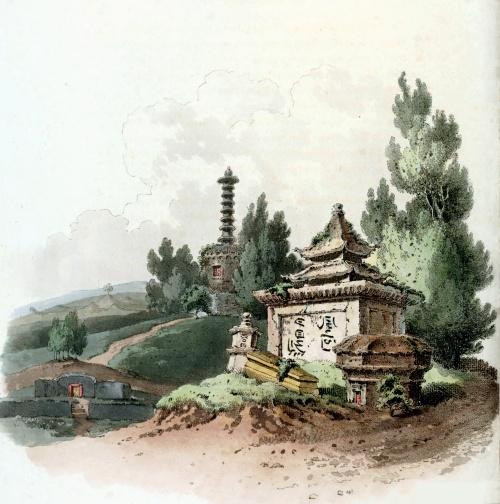
Cypress trees live to a good, long age; even though gnarled and twisted they still put out lush green growth. They are often planted near burial grounds, and so have a similar association to that of yew trees ➚ in Europe.
A cypress symbolizes longevity and can also symbolize ‘a hundred’ as it sounds the same as 百 bǎi as in the wish ‘may you have a hundred sons’. In some dialects it is pronounced bo which is the same as 伯 bó which means ‘earl, count’ and so may also symbolize a wish for promotion at work.
Finger lemon 佛手 fó shǒu
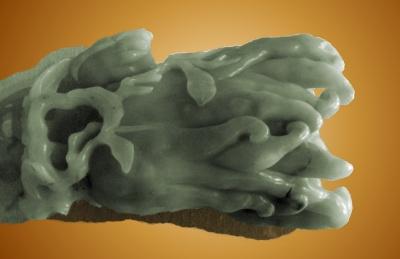
The finger lemon is a small citrus tree (Citrus medica) which bears a strange fruit with finger-like protuberances. It has been called ‘Buddha's hand’ (佛手 fó shǒu) or ‘Finger lemon’. It is rarely eaten in China, but instead hung up to give a fresh, citrus fragrance to a room. Symbolically it wishes a prosperous and long life because it sounds like 福寿 fú shòu ‘good fortune’ and ‘longevity’. In this regard it may be shown alongside a butterfly to express a wish for a long and happy retirement. It is also a good luck talisman by gamblers.
Ginseng 人参 rén shēn

Like the mandrake ➚ in Europe ginseng has long been associated with magical powers because its root is shaped like a human body (and hence the use of 人 rén ‘person’ in its name). It was believed that it cried when it was pulled out of the ground. From its coincidental shape it has been used as a powerful magic ingredient. It is now a well-known health tonic, but with no proven efficacy, it was originally harvested in Shanxi province, but now comes mainly from farms Jilin province and Korea. It has been collected so voraciously that is extinct in the wild in China.
Jujube 枣树 zǎo shù
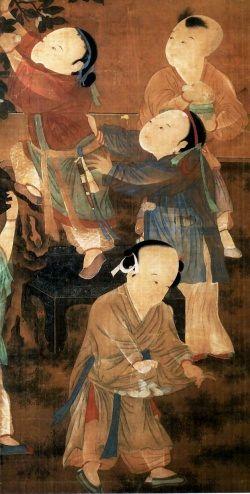
The jujube tree (sometimes called the Chinese date tree) bears succulent fruit. Because the sound zǎo is the same as in 早 zǎo ‘early’ a picture of a jujube tree gives the wish for ‘soon’. If combined with a lychee in a picture this can be taken to mean a wish for children to come quickly or if combined with a cinnamon tree a desire for rapid promotion to high office.
Lily 百合 bǎi hé
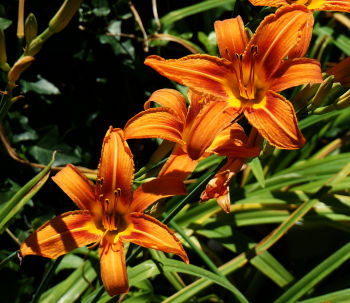
The species of lily most prized in China is the ‘day lily’ (Hemerocallis ➚) whose blooms only last one day. The transitory nature of the flowers is said to help you forget your troubles. Its rapid sequence of flowers makes it a symbol for childbearing and is therefore a suitable gift for newly weds. The grace and beauty are associated with foot binding as an Emperor extolled the virtue of the tiny feet in terms of ‘wherever she steps a lily flowers’ and so bound feet became termed ‘golden lilies’. The tiger lily (Lilium lancifolium) is widely grown and admired, it has the Chinese nickname 百合 bǎi hé as it can flourish in lots of different locations.
Irises are also called 百合 bǎi hé and are considered good for keeping evil at bay particularly at the Dragon boat festival where they were used to decorate doorways.
Lotus 荷花 hé huā
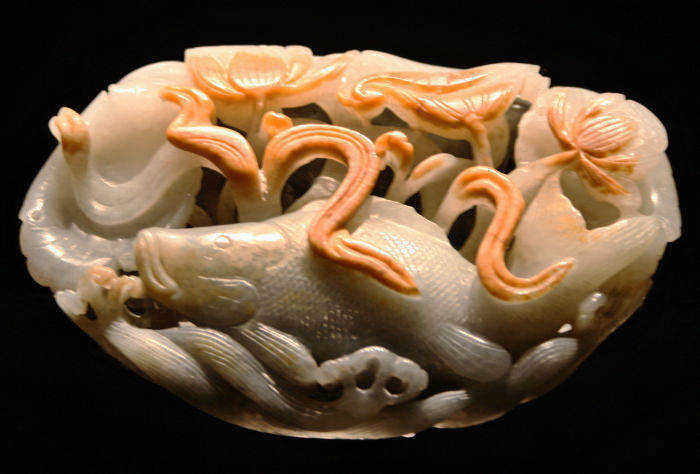
The lotus is a much revered motif in Chinese art. Its symbolism comes from Buddhism, it is a plant that grows in the stinking mud of marshes and yet produces pure white blossom, so it symbolizes transformation from evil to good. It directly symbolizes summer, purity and fruitfulness. The Buddha is said to have contemplated a bank of lotus plants; some mired in mud; some in bud; some below water. He saw these plants as representing the people who wished to flourish with full purity of mind. The lotus is also known as 莲 lián in Chinese and homophones to lian give it symbolic meanings: 廉 lián ‘incorruptible, modest’; 连 lián ‘joint, continuous, successive’; 联 lián ‘unite, join’. Another name for the lotus hé brings other associations through the homophones 和 hé ‘harmony, union’ so two lotus flowers symbolize the wish for marital harmony. There are many other associations: one of the eight immortals He Xiangu holds a lotus flower; as well as one of the Heavenly twin (He-he) boys; a lotus with a goldfish symbolizes the wish for an abundance of gold; with a duck a wish for happiness; with a heron a desire for progression... the list is almost endless. Like the lily, the lotus has been associated with bound feet to express their beauty.
It belongs to its own botanic family Nelumbonaceae ➚ separate from the somewhat similar water lily. All parts of the plants have their own name and usage; the fruits and leaves as food; the seeds as medicine. The wheel-like form at the center of its flower symbolizes the wheel of life.
The best known Buddhist mantra ‘Om mani padme hum’ 唵嘛呢叭咪吽 ǎn ma ní bā mī hōng can be very roughly transliterated as “May I become like the jewel of the Lotus. Amen” 叭咪 bā mī as ‘padme’ is the Tibetan name for lotus. The Lotus Position ➚ (padmāsana) is a compact cross-legged position for meditation inspired by the structure of the lotus.
Lychee 荔枝 lì zhī
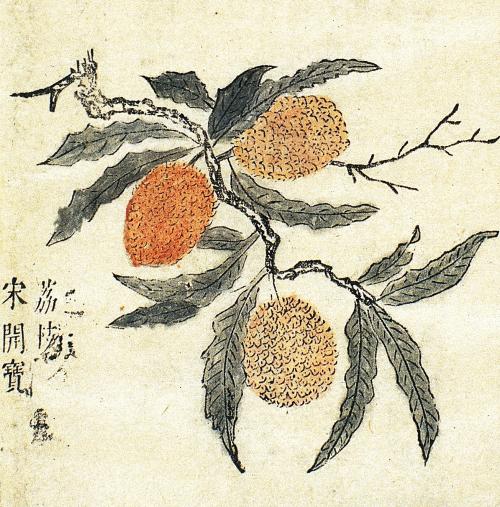
The Lychee or Lichee is best known for its white juicy fruit produced in late summer; the flesh of the fruit surrounds a large, gnarled kernel. In art it symbolizes summer and a wish for children, and so has a role in the marriage celebration. If lychees are combined with water chestnuts they symbolize cleverness: 伶俐 líng lì. The fruits are considered yang in traditional medicine and so are eaten to offset an excess of yin.
Magnolia 木兰花 mù lán huā
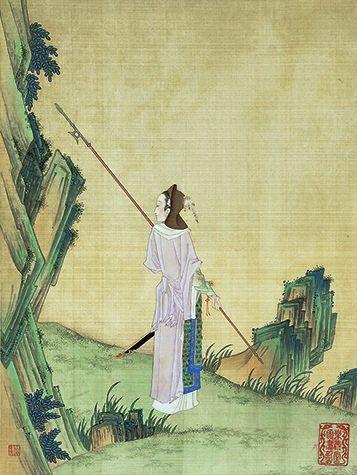
The magnolia is a much loved flower in China. Over the centuries varieties have been selectively bred for early flowering, bloom size and color. An early flowering variety is called 欢春花 Huān chūn huā ‘the flower that welcomes the spring’. Legend has it that at one time only the emperor himself and his closest favorites were allowed to grow the shrub.
Like the peony it symbolizes female beauty and so with a butterfly symbolizes a young man's quest for love. Magnolias are also known as 玉兰花 yù lán huā ‘jade orchid flower’ and together with a crab apple 海棠 hǎi táng and peony give 玉堂富贵 Yù táng fù guì meaning wishing for wealth and honor as ‘Jade Hall’ (yu tang) was the academy of scholars. In a painting with bees and magnolia give the meaning of self-esteem. The bark of the plant is used in traditional medicine.
The name 木兰 Mù lán is most associated with a warrior-maiden who took to the military to save her father from forced service some time in the Period of Disunity; she served many years and rose to a high rank and the whole time her true gender went undiscovered. The story was made into a successful Disney animated film ‘Mulan ➚’ (and a less successful re-make ➚).
A much loved species is Magnolia denudata ➚ known in China as 玉兰 Yù lán ‘jade orchid’ as pure white blossoms. The flowers have a citrus aroma that can carry on the wind for miles; the petals can be made into delicious food by covering in light batter and deep frying.
Maple 枫木 fēng mù
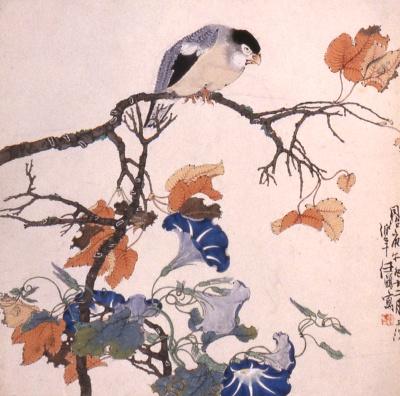
In a typical ‘sounds like’ allusion, a 枫 fēng maple in a picture confers the wish for an appointment because of the identically sounding 封 fēng ‘grant, confer’. The idea of a wish for appointment to a good job can be expressed by a monkey seeking a red box in a maple tree, where the package represents the seal of office (封侯褂印 fēng hóu guà yìn).
Melon 瓜 guā
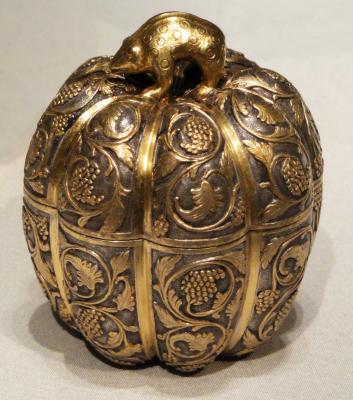
The round melon fruit represents a pregnant woman’s ‘bump’ and is full of seeds and so in a painting symbolizes a wish for many children (sons). Melons are often shown with vine like foliage. The town of Turpan in Xinjiang is famous for growing many sweet melons in the hot summer heat. Before modern times these were rare and expensive luxuries - an emperor might send them as a special reward to a valued official.
Mulberry 桑 sāng
The hollow trunk of the mulberry tree 浮桑 fú sāng was considered the resting place of the sun and also Imperial rulers.
White mulberry trees are very widely planted in China because they are the food plant of the silkworm. A mulberry tree was considered sacred during the Shang dynasty maybe because of the connection to silk. They were considered unlucky if placed in front of a house because 桑 sāng sounds like 丧 sàng which means ‘loss, mourning and death’. In some areas a twig of mulberry was worn to indicate that you were in mourning. Black mulberry trees (Morus nigra) are grown for their fruit and not found in China.
Narcissus 水仙 shuǐ xiān

As it sprouts and flowers each year in spring the Narcissus is named literally a ‘water immortal’ and in a painting may symbolize the immortals and good fortune. Stones, bamboo and narcissii together give the wish ‘may the immortals grant a wish for a long life’. Their flowering time is usually just right for the New Year festival. Families force them to flower early by growing in a pot with water and pebbles. It is particularly treasured in Fujian province.
There is a similar and often confused plant – the Sacred Lily 万年青 wàn nián qīng (Rohdea japonica) which is similar to the arum lily as it has red berries but strap-like leaves like the narcissus. As a gift it gives the wish for a venture to prosper for 万年 wàn nián ten thousand years .
Onion 葱头 cōng tóu
From the late 19th century onwards onions have come to symbolize cleverness as 葱 cōng sounds the same as 聪 cōng ‘clever, sharp witted, wise’.
Opium 阿芙蓉 ā fú róng

For centuries opium was used as a medicine. It was when opium was smoked that it became addictive and caused problems. Opium poppies were grown in the south west of China - particularly in Yunnan. The poppy flower appears on some porcelain and represents the twelfth month.
Originally it was not illegal to buy opium, but a ban on importing the drug into China was introduced. The British inherited an existing opium production area in northern India and began the opium trade with China when they conquered India. This opium was purer and cheaper than that produced in China and began to be illegally imported. It was the middle ranking officials who seem to have suffered most from addiction and this brought the whole Imperial administration to near collapse. (see our full article on the 'Opium Wars'.)
Orange 橘 jú

Oranges are grown in southern China and are popular presents for children. The character 桔 jú is made up of the radical 木 mù ‘wood’ and 吉 jí ‘lucky’. Also ju sounds close to 祝 zhù ‘to wish’ so it symbolizes a wish for good fortune. Persimmons and tangerines together give a wish for success in all things. In addition orange peel is considered an effective medicine. Lots of oranges and tangerines are consumed at the New Year festival; this trade had its origin in a tribute of oranges sent from Fujian province to Beijing in time for the spring festivities.
The boy Lu ji is put forward as an example of devotion to parents because when he was given some oranges instead of eating them himself he gave them to his mother. A boy shooting an arrow at three oranges indicates a wish for him to come first (hit the target) in all three levels of examinations, here the orange is just a symbol for a circle 圆 yuán to form 连中三元 lián zhòng sān yuán.
Orchid 兰 lán
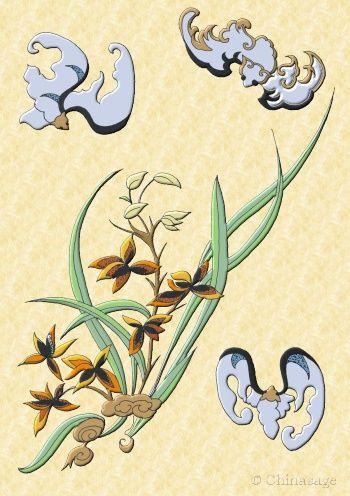
The orchid and particularly its fragrance is associated with female beauty, it stands for modesty and refinement. Although beautiful it tends to grow in small groups in isolated areas rather than as a great mass of blooms. There are very many different types of wild orchid in China which are highly prized. Lan is a popular girl's name.
The orchid was even praised by Confucius as an emblem of the perfect man. Together with bamboo the orchid is considered an ideal subject for painting. The ability to capture the daintiness and fragility of the flowers and foliage is a great skill. According to the Yi Jing ‘marital sharpness is broken when they are in harmony, the words of harmony are as fragrant as orchids’. The early poet and statesmen Qu Yuan, immortalized by the Dragon Boat Festival, likened the career of scholars to fragrant orchids that can only prosper under a wise and just ruler. It is one of the four noblemen (四君子 sì jūn zǐ) that represent the four seasons where it stands for spring. Cultivation of orchids in Chinese gardens goes back a long time, the first book on their care dates back to 1233.
Young women who did not want to marry joined the Golden Orchid Society in Guangdong in the 19th century. The society was violently suppressed as it was considered immoral for a woman not to marry.
Peach 桃 táo
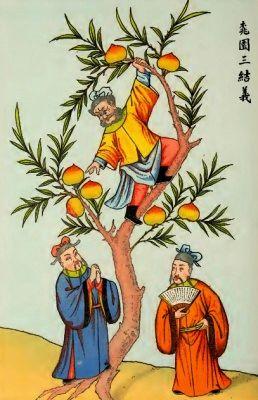
Peaches are a common art motif. The most famous association is with the peaches of immortality that grow in the gardens of the Queen Mother of the West (Xiwangmu). These trees bear fruit only once every three thousand years. The god of longevity is often portrayed emerging from a peach. The monkey king stole some of the fruits causing consternation in heaven and required the intervention of the Jade Emperor according to the very famous story: The Journey to the West.
Peach trees are grown throughout China and many parts of the plant are used in traditional medicine. The timber is reputed to keep away demons and branches were placed at the entrance to houses at New Year for this purpose (this is probably due to the homophone 淘 táo ‘to eliminate’).
A peach orchid was the setting of a very famous event in Chinese literature. In the ‘Romance of the Three Kingdoms’ 三国志演义 Sān guó zhì yǎn yì Liu Bei, Guan Yu and Zhang Fei swore an oath of enduring loyalty to each other in a peach orchard.
Just as in Europe, spring is a favorite time for marriages and as this is the season for peach blossom, they are associated with marriage. The fresh complexion of a girl is likened to the blush of a peach. A birthday greeting can sometimes be represented as a peach tree on a mountain with bat and waves to give the greeting 福如东海寿比南山 Fú rú dōng hǎi shòu bǐ nán shān 'may your good fortune be as deep as the eastern ocean and may you live as long as the southern mountain'.
Pear 梨 lí
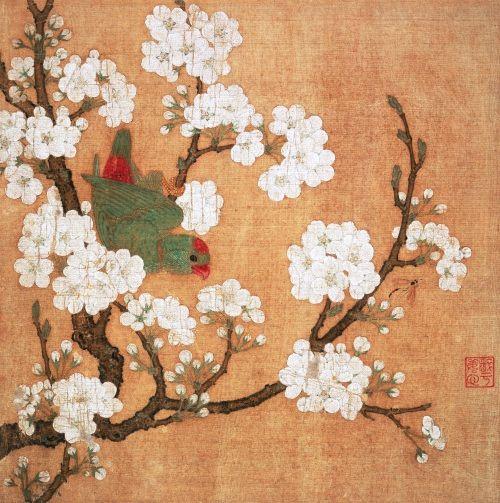
Pears are a long lived fruit tree, as they can survive for 350 years, and so they symbolize a wish for a long life. However unlike most other fruits the pear has a unfortunate homophone as 离 lí means ‘separate; divide’ so it should never be given as a present to a couple. For the same reason it is inappropriate at the Hungry Ghost Festival as that would indicate separation from the spirit of the ancestors. Pear blossom with raindrops is considered one of the most beautiful sights and so is associated with a beautiful girl. Parts of the plant are used as medicine for fever and diarrhea.
Tang Emperor Xuanzong instigated an operatic troupe in his pear orchard and so members of the theatrical profession are known as ‘followers of the pear orchard’ 梨园子弟 lí yuán zǐ dì.
Peony 牡丹 mǔ dān

The tree peony is one of the most loved flowers in China. It became mudan after centuries of being known as 芍药 sháo yào possibly due to the appearance of a red variety (as dan is one word for ‘red’). White peonies 白牡丹 bái mǔ dān represent talented young girls with wit as well as beauty. A peony symbolizes, as many flowers do, a young girl. ‘The Peony Pavilion’ 牡丹亭 mǔ dan tíng is a very famous Kunqu Opera 昆曲 about young love. The peony has a double flower and that has led to a hidden meaning of a wish for repeated riches. The tree peony can grow quite tall 6 feet [2 meters] and live for a hundred years. Districts in Henan and Shandong provinces attract many visitors during the flowering season, it is regarded with the same affection as the rose is in the west.
A legend has Empress Wu Zetian ordering all flowers to bloom in winter for a festival. Somehow all flowers bloomed except the peonies. So she had them dug up and put on a fire but as they burned they bloomed and put out the fire. For its continued opposition she had all the peonies sent to Luoyang where they have flourished ever since. There is some truth to this legend because when peony stems are singed the plant produces larger and finer flowers.
The flower was much admired in the works of the great Tang poets. On occasions it is considered the flower of spring and competes with the lotus, chrysanthemum and plum for supremacy. Together with the peony all four flowers represent the whole year. The health of a garden peony was thought to mirror that of its owning family, if it should fall sick it was an ill omen. In combination with other symbols such as the phoenix, pheasant and peacock a peony represents a good reputation.
Persimmon 柿 shì
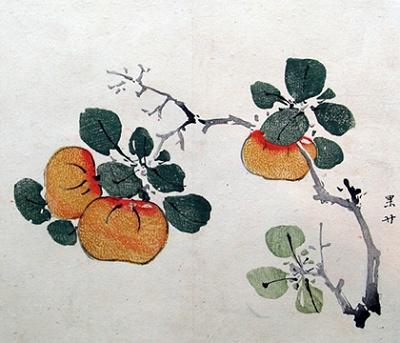
The persimmon is grown for its large juicy fruits and is sometimes called the ‘Chinese fig’. It grows well on the mountain slopes of northern China. The fruits are orange and shaped like beef tomatoes. The bright orange/red color makes it suitable for festive decorations.
As 事 shì ‘matter; business; affair’ sounds the same, it is used to combine with other objects to give good wishes for an undertaking. With oranges (tangerines) it means ‘good luck in your affairs’ with an apple it means ‘contentment in affairs’. A persimmon with a pine tree and an orange wishes good luck in ‘a hundred business matters’ (百事吉利 bǎi shì jí lì). It is often planted in temple gardens as it is said to have four virtues: long life; sheltering birds; giving shade and freedom from insect pests.
Pine 松 sōng
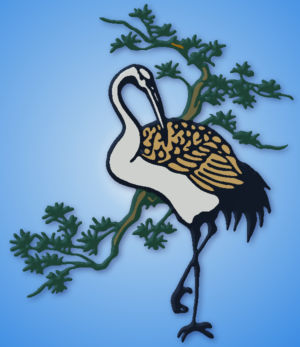
The pine tree is one of the three friends of winter - together with plums and bamboo because it is evergreen and does not drop its needles. It is a favorite subject in Chinese landscape paintings. It symbolizes longevity, solitude and steadfastness; as the needles grow in pairs it is also a symbol of married bliss. With a crane a pine tree gives the wish for a peaceful and long life.
Pine trees are commonly planted around graveyards (see also cypresses) perhaps due to the association of longevity or may be due to a legend that the graveyard demons 罔象 wǎngxiàng are kept away by them. It was forbidden to cut down any tree planted in a graveyard - under pain of death. Bunge's pine ➚ 白皮松 bái pí sōng is widely grown as an ornamental pine tree in parks and gardens.
松籁 Sōng lài or 松涛 sōng tāo is the music of pine trees as the wind soughs through its needles and branches and is much loved by the poets. A pine tree at the foot of the sacred Mount Taishan, Shandong was granted an official's title by the first Qin Emperor Shihuangdi - the ‘Welcoming-Guest Pine’, but it has been replaced a number of times over the succeeding centuries.
Plum 梅 méi
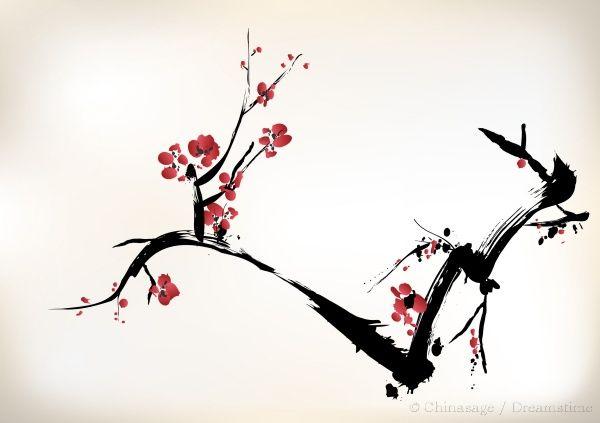
The welcome blossom of plum trees in late winter has made the plum tree popular. It is one of the three friends of winter with the bamboo and the pine tree. It is also widely known by the character 李 lǐ which is made up of two elements ‘wood’ and ‘child’ suggesting the prolific fruits produced by the tree. 桃李 Táo lǐ ‘peaches and plums’ is a phrase to refer to school children. The four plants plum, bamboo, orchid and chrysanthemum represent the four seasons of the year - winter through to autumn (the 四君子 sì jūn zǐ four gentlemen).
Because the flowers emerge before the leaves and it takes a long time to come into flower it is associated with longevity. It is often shown with a crane, another symbol of longevity; with a ruyi it is a wish for a peaceful, long life. A plum tree at Huangmei, Hebei is believed to be 1,600 years old. A popular pattern has plum blossom over cracked ice to symbolize Spring. As the Chinese Spring Festival may fall as late as mid-February, it flowers at the end of the Chinese season of winter. Li or Lee is one of the most common family names in China.
The Daoist philosopher Laozi is said to have been born beneath a plum tree. It has been a popular subject for poetry for centuries. The Song dynasty poet Lin Bu is said to have spent his spare time feeding cranes and planting plum trees near West Lake, Hangzhou. The five petals of the flower represent one of the many ‘fives’ in Chinese symbolism including the five gods of prosperity; five good fortunes; five good luck gods and so on.
Pomegranate 石榴 shí liu
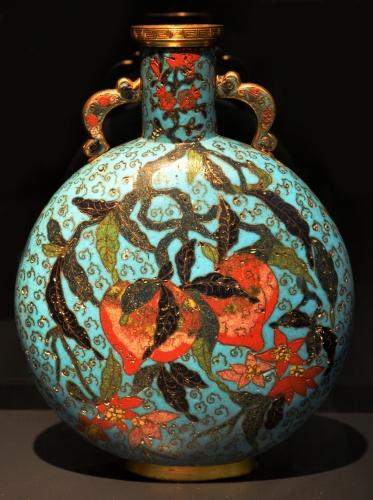
The pomegranate fruit is brim full of seeds, and as seed in Chinese 子 zǐ also means children, it chiefly symbolizes a wish for many children. This can be emphasized by portraying children with pomegranates in a picture. The pomegranate is sometimes known as the ‘Chinese apple’. The first trees were brought into China from Afghanistan during the Han dynasty. It is an appropriate as a marriage gift with the inscription 榴开百子 liú kāi bǎi zǐ ‘the pomegranate brings forth a hundred seeds/sons’. It sounds the same as 十六 shí liù ‘sixteen’ and so is also associated with commemorating a sixteenth birthday. In symbolism a pomegranate may represent a wish for a title to be continued into the next generation as 世 shì means ‘generation; noble’. The pomegranate is the emblem of the tenth month of the traditional calendar.
Rose 蔷薇 qiáng wēi

In Europe the rose is one of the most frequently seen motifs and often represents love with its bloom, fragrance and thorns. Not so much in China, despite the fact that many species of rose planted in Europe and America originate from China. It may symbolize youth and together with bees, sweetness, but more commonly will be seen on goods destined for export.
Walnut 胡桃 hú táo
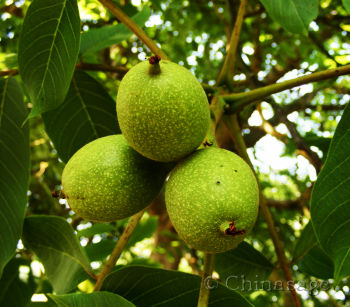
The walnut may have come to China quite late, the term 胡 hú probably relates to people to the north of China who introduced the tree after the Han dynasty. 胡桃 Hú táo also means ‘flirt’ because of a story of a couple who were estranged for a long while, when the husband (named Hu) returned he flirted with his own wife as he failed to recognize her. So a walnut has come to symbolize a flirtation.
Willow 柳 liǔ
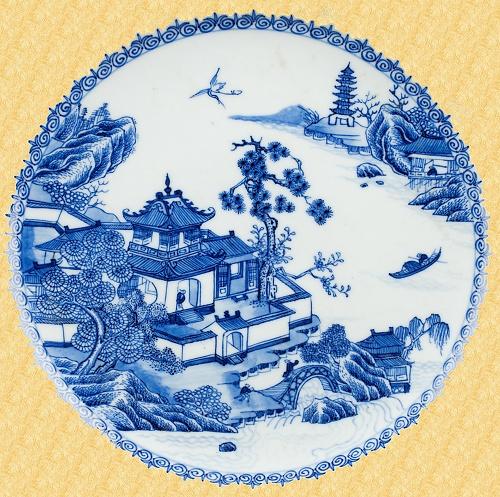
The widespread willow is a very useful tree. It provides material for all sorts of purposes including baskets, ropes and firewood. It is associated with spring and so also with romance. The grace of a willow tree is often compared to the meekness and charm of a young woman. In combination with a swallow it symbolizes artistic ability. Willow is believed to keep evil spirits at bay and is often seen in the form of a willow broom at the Qing Ming festival for this reason. At this festival it was traditional to snap off small branches of willow at the graveyard and take them home to hang at the entrance gate as a sign of spring. It is widely prescribed in traditional medicine, and this has proven efficacy as willow bark is a source of salicylic acid (aspirin).
The famous willow pattern on porcelain, widely exported to Europe and imitated by European potters, immortalizes the tale of young love where a poor young man falls in love with the daughter of his rich employer. Many of the elements in the willow pattern design relate to incidents in the story. A willow tree is featured prominently and hence gives its name to this design.
When people left home they were often given willow twigs as a parting gift as li sounds the same as 离 lí ‘to part’. Willow will sprout readily from cuttings and so the twig can then be planted to give an enduring reminder of home.
Wood oil tree 梧桐 wú tóng
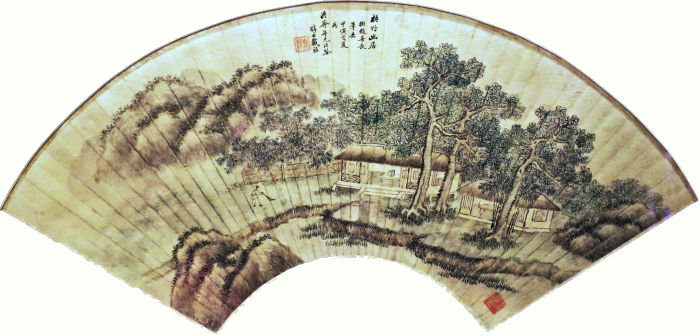
There are several trees given the general term 同 tòng including the Parasol tree (Firmiana simplex ➚) and Paulownia imperialis ➚. Because tong also means ‘shared, joint, together’ the tree represents a wish for a shared and peaceful life and as it lives for a long time it also symbolizes longevity. A magpie 喜鹊 xǐ què in a wutong tree symbolizes ‘joy together’ 禧同 xǐ tóng.
Paulownia imperialis produces an oil that is very useful for preserving wood - and from this comes its English name. Its wood is also used to make excellent guqin musical instruments. The tree is associated with the phoenix and also the yin property. As the phoenix is such an auspicious creature wutong trees were planted in the hope it may attract one to land on it.